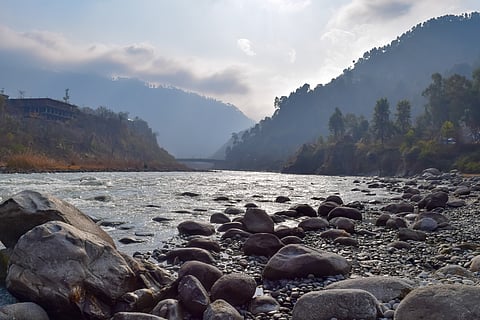

The serendipitous charm of Chamba holds its own before the conceited cantonment towns and fashionable colonial summer capitals. The palimpest of a historical kingdom believed to be founded a century and a half ago, and its traces distilled into a modern capital, Chamba town is known for its dairy products, its fiery red chilli pickle-paste 'Chamba Chukh', and its streets selling its famed GI-tagged rumaals and chappals. The town of Chamba was founded in 920 CE by Raja Sahil Varman. Bound by the Dhauladhar and Pir Panjal ranges and fed by the Ravi River, Chamba was a mighty Himalayan kingdom till the British empire brought it under the colonial administration of undivided Punjab. This town is known for the artistic traditions of its people and the architectural marvels that were built between the 8th and 10th centuries CE. Be it the chaotic charm bubbling over like the fragrant milky tea of its markets or the playful course of the river Ravi beside the ancient meditative grace of its stone-carved temples, the town has plenty to convince the first-time visitor, jaded with the bustle of urban life, to keep coming back. Here is a guide to things to do on a weekend break in Chamba.
Strolling at Chaugan
The sprawling meadow-style park&mdashthe kind you&rsquore unlikely to find so high up in the hills&mdashis often termed the heart of Chamba and is ideal for starting your exploration of the town. The snowy mountains tower over you wherever you stand. You will spot cricket lovers giving their best shot competing against that other more illustrious, pristine sporting glory of the Dharamshala Cricket Ground.
The Chaugan premises also house the town bazaar where you can score some fine silver jewellery and Chamba&rsquos famed embroidered chappals. And don&rsquot forget to buy a few bottles of chukh. Stop at one of the dhabas around for the lip-smacking Chamba delicacy, madhra (rajma-chawal laced with ghee and dahi). Those visiting in the months of July-August can witness the week-long colourful celebration called the Minjar Mela, which features processions, tribal performances, sporting events, and other attractions.
No Miniature Matter
As one takes a leisurely walk in the galleries of the Bhuri Singh Museum, named after a local ruler, the collection of rumaals, musical instruments, copper plates and silver coins helps conjure up the rich royal heritage of the region. Some of the paintings&mdashPahari miniatures in the Chamba, Kangra, Guler and Basholi schools&mdashare rather well-versed with the language of the birds and the bees, while others depict the slaying of demons and scenes like Ravana&rsquos unwitting court minions setting Hanuman&rsquos tail on fire. Head to Amichand Dheema&rsquos in the Chaugan bazaar for some miniatures to carry back home.
Watch the Ravi Go By
Chamba is set by the banks of the Ravi, which is one of the five aabs, or rivers, of the Punjab. Here, the river gushes and breaks over round rocks, its water radiating all the shades of blue that we&rsquore accustomed to seeing in paintings. To get a view, either get to the riverside of the Chaugan, or, better still, get down to the river bank like the rest of the locals, munching on til chikki. Listen to the sound closely, it might even tell you its ancient name &mdash Iravati. Or simply get a spot to sip on some khatta at the HPTDC viewpoint restaurant, Café Ravi View, and watch the river go by.
Chamba Temple Circuit
Most people travelling to Chamba come here for its impressive array of ancient wooden and rock-cut temples. The Hari Rai Temple houses the four-faced and much-storied Vishnu Vaikuntha statue, which was purloined by international art thieves in the 1970s, but found months later at the Bombay docks. Walk uphill through the winding streets of the Dogra Bazaar, to reach the sprawling 10th-century Lakshmi Narayan temple complex&mdashwith six nagara-style stone temples that are definitely worth doing a separate temple excursion for. The Sui Mata Temple, in the Chaugan area, constructed in honour of queen Sui, King Sahil Varman&rsquos wife, must be visited for the lovely painting depicting her life. Higher up the stairway is the famous Chamunda Devi Temple, with a striking sweeping view of the town, with the playful waters of the Ravi streaking the landscape.
Immerse In Nature
If you want to explore the countryside, there are plenty of options too. Jhumhar, 10km away, is known for its alpine meadow and apple orchards you can go on a picnic to Sarol, 11km away, and known for its sheep breeding centre apiary Saho, 18km away, a picturesque plateau by the Sal river, is famous for the Chandrasekhara Shiva temple.
Festivals
The town hosts the annual Minjar Fair in July/August (July 26-August 2, 2015) at the central Chaugan (meadow). This is the time when the gods and goddesses from various temples of the Chamba valley arrive in their palanquins to meet the main deity, Raghuvira. People indulge in sporting and cultural activities, dressed in their colourful traditional attire.
Getting There
By Air The nearest airport to Chamba is the Pathankot Airport, at a distance of 120 km. The other closest airport is at Gaggal, Kangra, which is at a distance of 150 km from Chamba. By Rail The Nearest railway station is Pathankot, about 120 km from Chamba.
